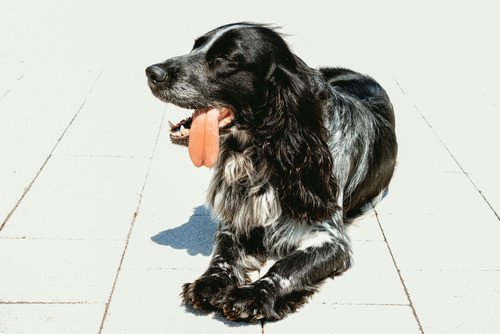As temperatures rise, it’s crucial to be vigilant about the signs of heat exhaustion in dogs. Our furry friends are more susceptible to heat-related illnesses than humans due to their limited ability to cool down. At Chimacum Valley Veterinary Hospital in Port Hadlock, WA, we are dedicated to helping you keep your dog safe and comfortable during the warmer months. Understanding the signs of heat exhaustion can make a significant difference in your dog’s health and well-being. If you notice any concerning symptoms, call (360) 385-4488 or request an appointment online.
Recognizing the Early Signs of Heat Exhaustion in Dogs
Early detection of heat exhaustion in dogs is vital for preventing more severe conditions like heat stroke. The signs of heat exhaustion in dogs can manifest in various ways, and knowing what to look for can help you take prompt action.
Excessive Panting and Drooling
Panting is normal for dogs, but excessive panting can be a sign of heat exhaustion. When a dog is struggling to cool down, they will pant more intensely. You may also notice excessive drooling. These are your dog’s primary methods of cooling down, and excessive amounts indicate that they are overheating.
Elevated Heart Rate and Breathing
Heat exhaustion causes a dog’s heart rate and breathing to increase. If your dog seems to be breathing rapidly or if you can feel a significantly elevated heart rate, it’s a sign that they are trying to cope with the heat. This rapid breathing is their attempt to expel excess heat from their body.
Lethargy and Weakness
A dog experiencing heat exhaustion will often become lethargic and weak. They may not respond to your calls or show interest in activities they usually enjoy. This lack of energy is a clear indication that their body is under stress due to the heat.
Vomiting and Diarrhea
Vomiting and diarrhea can occur as the body reacts to overheating. These symptoms can quickly lead to dehydration, exacerbating the problem. It’s essential to seek veterinary care immediately if your dog shows these signs, as they can become severe very quickly.
Advanced Signs of Heat Exhaustion in Dogs
If heat exhaustion is not addressed promptly, it can escalate into more serious conditions. Advanced signs of heat exhaustion require immediate medical attention to prevent life-threatening complications.
Disorientation and Stumbling
Disorientation and stumbling are clear indicators that your dog is suffering from severe heat exhaustion. These symptoms suggest that the dog’s body is no longer able to regulate its internal temperature effectively. They may appear confused, have trouble standing, or seem unsteady on their feet.
Collapse and Unresponsiveness
In extreme cases, a dog may collapse or become unresponsive. This is a critical emergency, and you should seek immediate veterinary assistance. Collapsing indicates that the heat has overwhelmed the dog’s system, and they are at risk of heat stroke or even death.
Preventive Measures to Avoid Heat Exhaustion in Dogs
Taking proactive steps can significantly reduce the risk of heat exhaustion in your dog. Prevention is always better than treatment, and being aware of these measures can help keep your pet safe during hot weather.
- Providing Ample Water and Shade: Ensure that your dog always has access to fresh water and a shaded area when outdoors. Hydration is key to keeping their body temperature regulated. Shaded areas provide a cooler environment and help reduce the risk of overheating.
- Avoiding Midday Walks: Plan walks and outdoor activities for the early morning or late evening when temperatures are cooler. The midday sun is at its peak, and even short periods of exposure can lead to heat exhaustion. Keeping walks to the cooler parts of the day helps protect your dog from extreme temperatures.
- Using Cooling Products: Various cooling products, such as cooling vests, mats, and bandanas, can help your dog stay cool. These products are designed to absorb and dissipate heat, providing relief from high temperatures. They are particularly useful for dogs with thicker fur coats or those prone to overheating.
Emergency Actions if You Suspect Heat Exhaustion
If you suspect your dog is experiencing heat exhaustion, it’s crucial to act quickly. Taking immediate steps can prevent the condition from worsening and can save your dog’s life.
Moving to a Cooler Environment
The first step is to move your dog to a cooler environment, preferably indoors with air conditioning. If that’s not possible, find a shaded area or use a fan to help lower their body temperature. Reducing exposure to heat is the priority.
Applying Cool (Not Cold) Water
Apply cool water to your dog’s body, focusing on the head, neck, and chest. Avoid using ice-cold water, as it can cause blood vessels to constrict, slowing the cooling process. You can use a wet towel or a gentle spray from a hose.
Offering Small Amounts of Water
Allow your dog to drink small amounts of cool water. Drinking too much at once can lead to vomiting. Sips of water help rehydrate them without overwhelming their system. If your dog refuses to drink, seek veterinary care immediately.
Seeking Professional Veterinary Help
If your dog’s symptoms do not improve quickly or if they show signs of advanced heat exhaustion, seek professional veterinary help immediately. Heat exhaustion can escalate rapidly, and professional intervention is often necessary.
Calling Chimacum Valley Veterinary Hospital
At Chimacum Valley Veterinary Hospital, we are here to assist you with any heat-related concerns. Our team is experienced in treating heat exhaustion and can provide the necessary care to ensure your dog’s recovery. Call us or request an appointment online if you suspect your dog is suffering from heat exhaustion.
Protecting Your Dog from Heat Exhaustion
Understanding the signs of heat exhaustion in dogs can make a significant difference in preventing serious health issues. By recognizing the early and advanced signs, taking preventive measures, and knowing when to seek professional help, you can keep your dog safe during the warmer months. For any concerns or questions, contact Chimacum Valley Veterinary Hospital at (360) 385-4488 or request an appointment online. Your dog’s health and comfort are our priorities, and we are here to support you every step of the way.





